warning light FORD E SERIES 2002 4.G User Guide
[x] Cancel search | Manufacturer: FORD, Model Year: 2002, Model line: E SERIES, Model: FORD E SERIES 2002 4.GPages: 272, PDF Size: 2.6 MB
Page 136 of 272
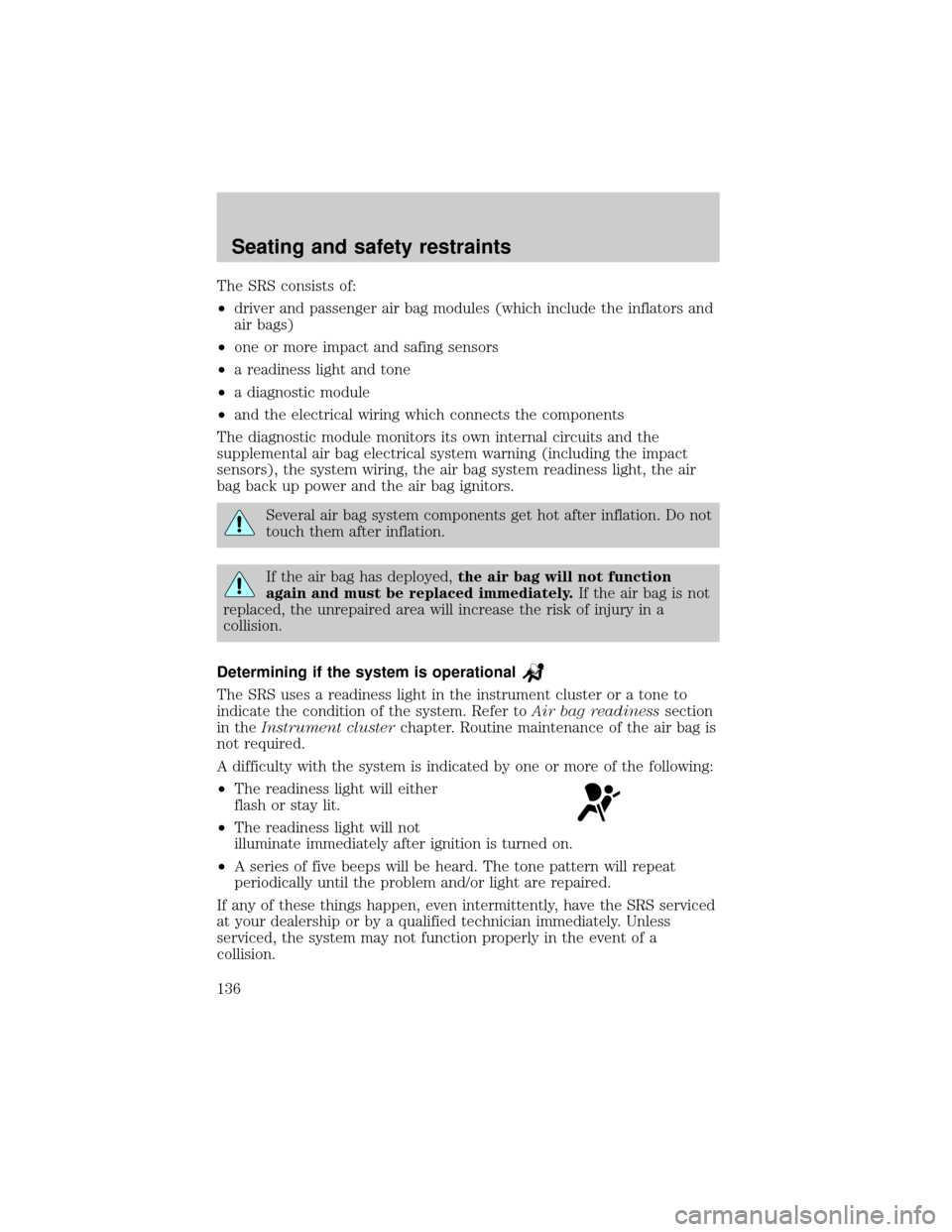
The SRS consists of:
²driver and passenger air bag modules (which include the inflators and
air bags)
²one or more impact and safing sensors
²a readiness light and tone
²a diagnostic module
²and the electrical wiring which connects the components
The diagnostic module monitors its own internal circuits and the
supplemental air bag electrical system warning (including the impact
sensors), the system wiring, the air bag system readiness light, the air
bag back up power and the air bag ignitors.
Several air bag system components get hot after inflation. Do not
touch them after inflation.
If the air bag has deployed,the air bag will not function
again and must be replaced immediately.If the air bag is not
replaced, the unrepaired area will increase the risk of injury in a
collision.
Determining if the system is operational
The SRS uses a readiness light in the instrument cluster or a tone to
indicate the condition of the system. Refer toAir bag readinesssection
in theInstrument clusterchapter. Routine maintenance of the air bag is
not required.
A difficulty with the system is indicated by one or more of the following:
²The readiness light will either
flash or stay lit.
²The readiness light will not
illuminate immediately after ignition is turned on.
²A series of five beeps will be heard. The tone pattern will repeat
periodically until the problem and/or light are repaired.
If any of these things happen, even intermittently, have the SRS serviced
at your dealership or by a qualified technician immediately. Unless
serviced, the system may not function properly in the event of a
collision.
Seating and safety restraints
136
Page 148 of 272
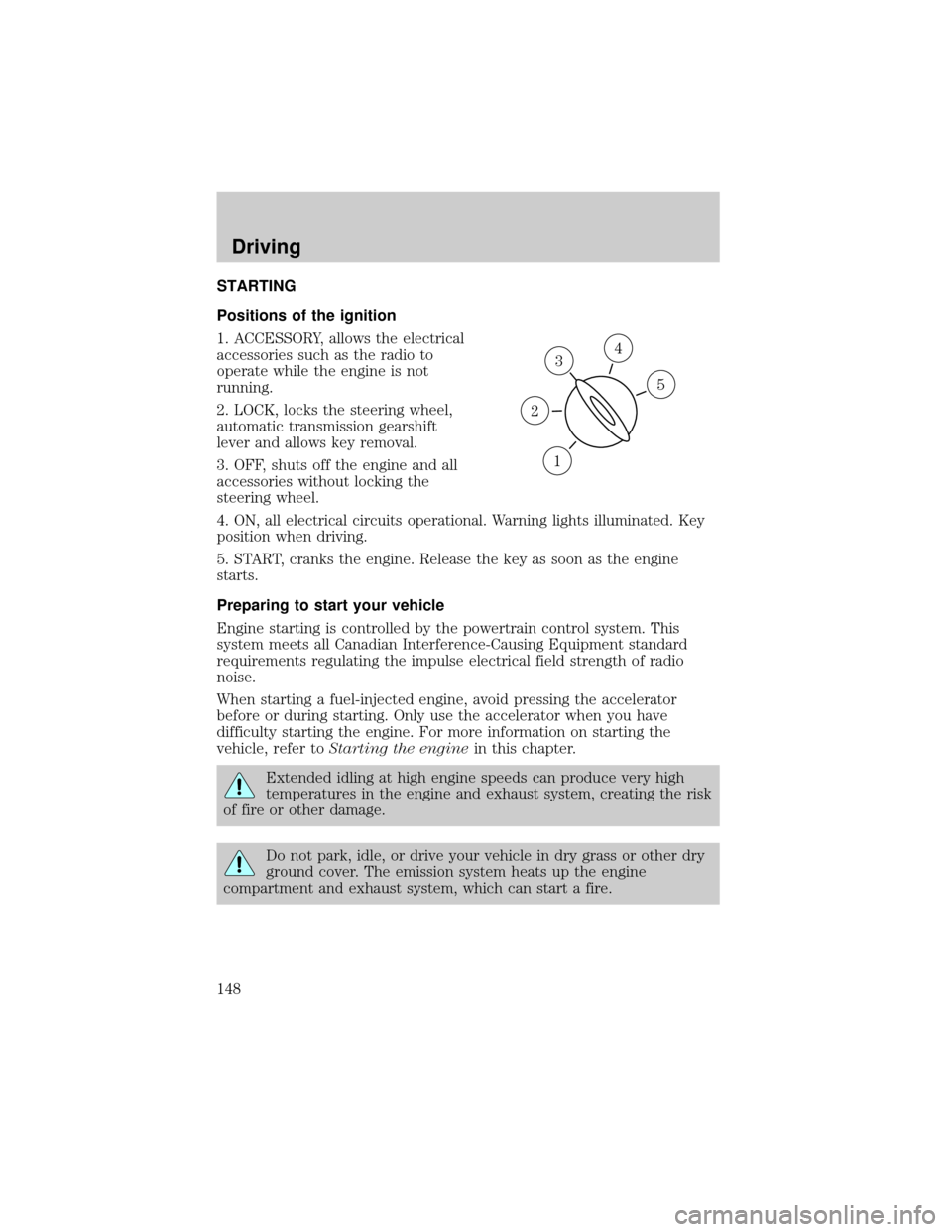
STARTING
Positions of the ignition
1. ACCESSORY, allows the electrical
accessories such as the radio to
operate while the engine is not
running.
2. LOCK, locks the steering wheel,
automatic transmission gearshift
lever and allows key removal.
3. OFF, shuts off the engine and all
accessories without locking the
steering wheel.
4. ON, all electrical circuits operational. Warning lights illuminated. Key
position when driving.
5. START, cranks the engine. Release the key as soon as the engine
starts.
Preparing to start your vehicle
Engine starting is controlled by the powertrain control system. This
system meets all Canadian Interference-Causing Equipment standard
requirements regulating the impulse electrical field strength of radio
noise.
When starting a fuel-injected engine, avoid pressing the accelerator
before or during starting. Only use the accelerator when you have
difficulty starting the engine. For more information on starting the
vehicle, refer toStarting the enginein this chapter.
Extended idling at high engine speeds can produce very high
temperatures in the engine and exhaust system, creating the risk
of fire or other damage.
Do not park, idle, or drive your vehicle in dry grass or other dry
ground cover. The emission system heats up the engine
compartment and exhaust system, which can start a fire.
3
1
2
5
4
Driving
148
Page 153 of 272
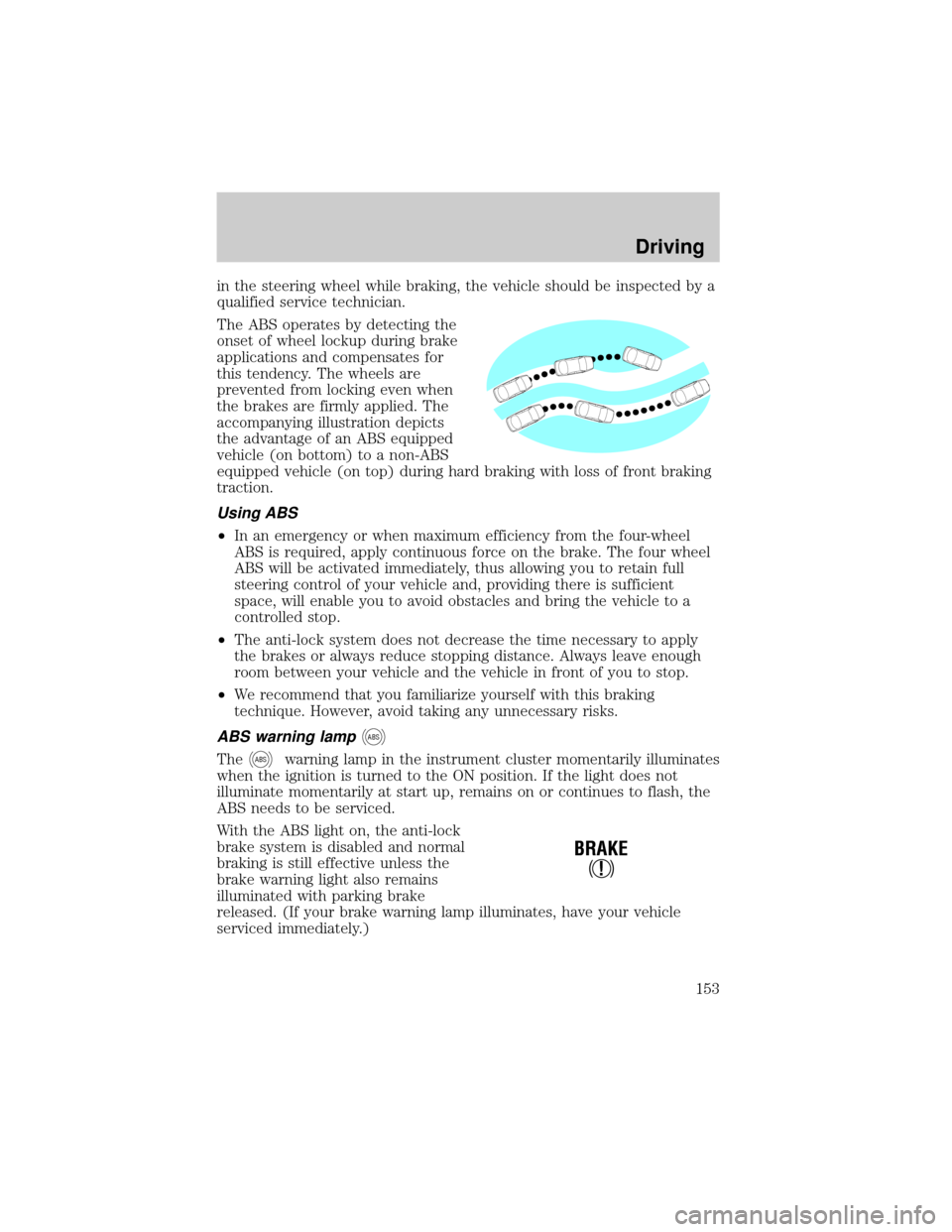
in the steering wheel while braking, the vehicle should be inspected by a
qualified service technician.
The ABS operates by detecting the
onset of wheel lockup during brake
applications and compensates for
this tendency. The wheels are
prevented from locking even when
the brakes are firmly applied. The
accompanying illustration depicts
the advantage of an ABS equipped
vehicle (on bottom) to a non-ABS
equipped vehicle (on top) during hard braking with loss of front braking
traction.
Using ABS
²In an emergency or when maximum efficiency from the four-wheel
ABS is required, apply continuous force on the brake. The four wheel
ABS will be activated immediately, thus allowing you to retain full
steering control of your vehicle and, providing there is sufficient
space, will enable you to avoid obstacles and bring the vehicle to a
controlled stop.
²The anti-lock system does not decrease the time necessary to apply
the brakes or always reduce stopping distance. Always leave enough
room between your vehicle and the vehicle in front of you to stop.
²We recommend that you familiarize yourself with this braking
technique. However, avoid taking any unnecessary risks.
ABS warning lampABS
TheABSwarning lamp in the instrument cluster momentarily illuminates
when the ignition is turned to the ON position. If the light does not
illuminate momentarily at start up, remains on or continues to flash, the
ABS needs to be serviced.
With the ABS light on, the anti-lock
brake system is disabled and normal
braking is still effective unless the
brake warning light also remains
illuminated with parking brake
released. (If your brake warning lamp illuminates, have your vehicle
serviced immediately.)
!
BRAKE
Driving
153
Page 157 of 272
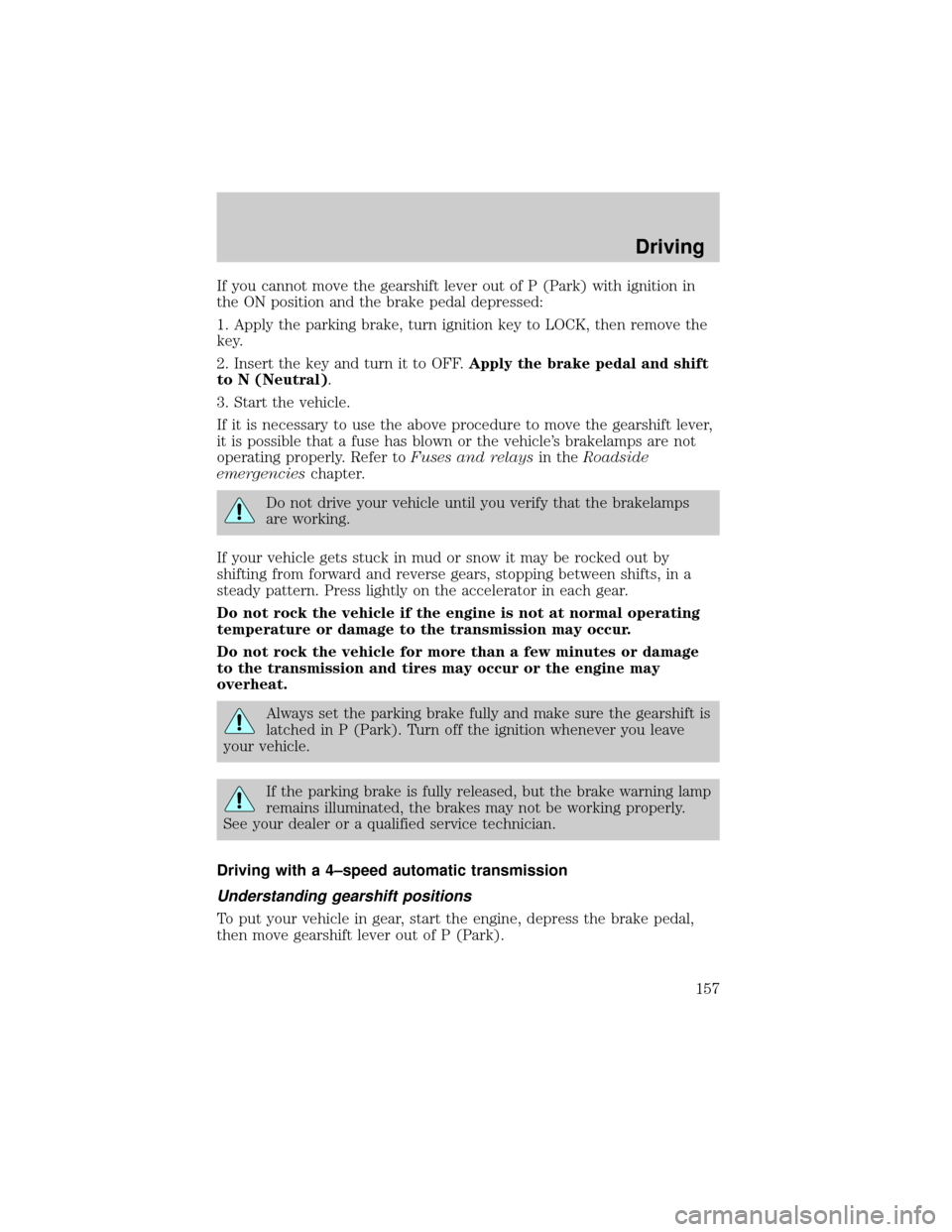
If you cannot move the gearshift lever out of P (Park) with ignition in
the ON position and the brake pedal depressed:
1. Apply the parking brake, turn ignition key to LOCK, then remove the
key.
2. Insert the key and turn it to OFF.Apply the brake pedal and shift
to N (Neutral).
3. Start the vehicle.
If it is necessary to use the above procedure to move the gearshift lever,
it is possible that a fuse has blown or the vehicle's brakelamps are not
operating properly. Refer toFuses and relaysin theRoadside
emergencieschapter.
Do not drive your vehicle until you verify that the brakelamps
are working.
If your vehicle gets stuck in mud or snow it may be rocked out by
shifting from forward and reverse gears, stopping between shifts, in a
steady pattern. Press lightly on the accelerator in each gear.
Do not rock the vehicle if the engine is not at normal operating
temperature or damage to the transmission may occur.
Do not rock the vehicle for more than a few minutes or damage
to the transmission and tires may occur or the engine may
overheat.
Always set the parking brake fully and make sure the gearshift is
latched in P (Park). Turn off the ignition whenever you leave
your vehicle.
If the parking brake is fully released, but the brake warning lamp
remains illuminated, the brakes may not be working properly.
See your dealer or a qualified service technician.
Driving with a 4±speed automatic transmission
Understanding gearshift positions
To put your vehicle in gear, start the engine, depress the brake pedal,
then move gearshift lever out of P (Park).
Driving
157
Page 179 of 272
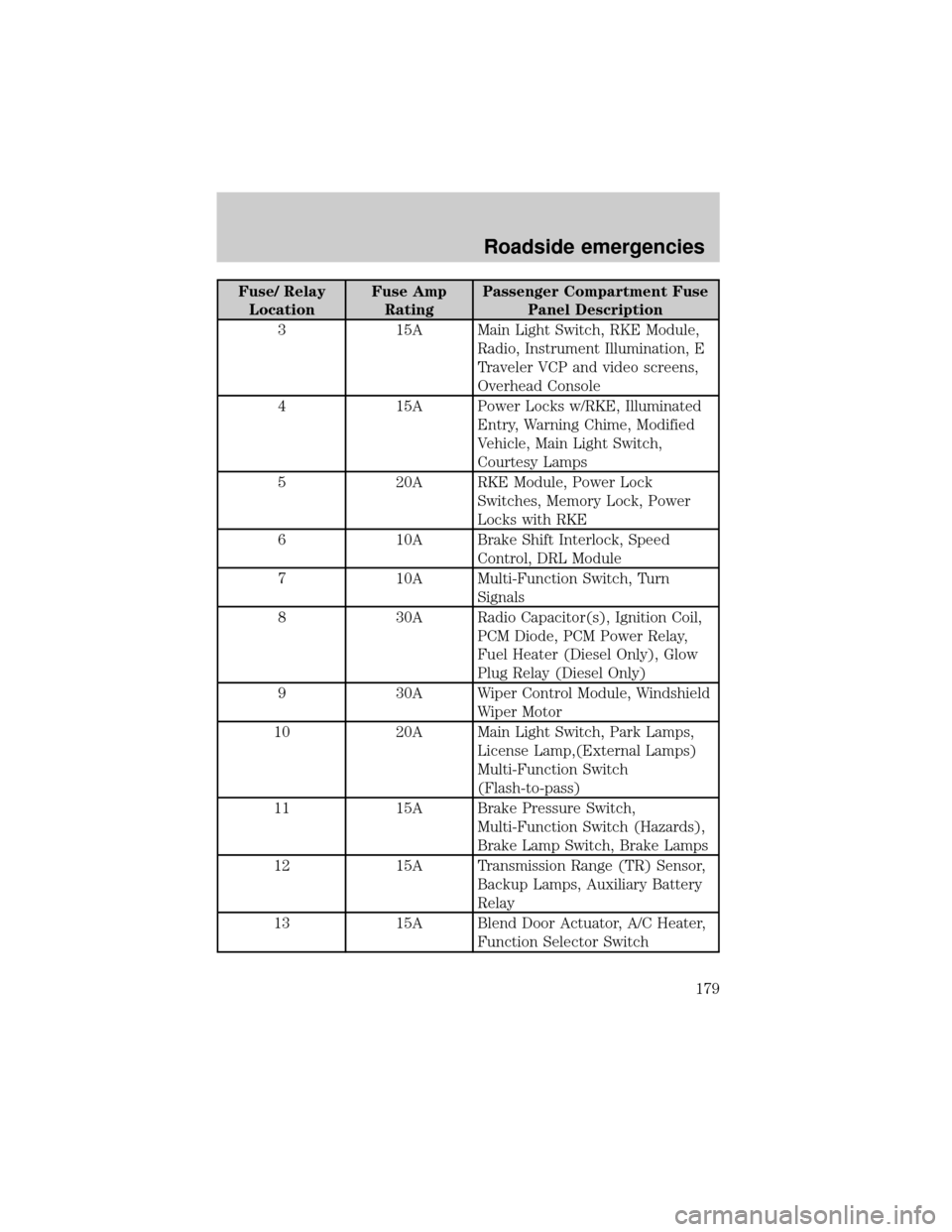
Fuse/ Relay
LocationFuse Amp
RatingPassenger Compartment Fuse
Panel Description
3 15A Main Light Switch, RKE Module,
Radio, Instrument Illumination, E
Traveler VCP and video screens,
Overhead Console
4 15A Power Locks w/RKE, Illuminated
Entry, Warning Chime, Modified
Vehicle, Main Light Switch,
Courtesy Lamps
5 20A RKE Module, Power Lock
Switches, Memory Lock, Power
Locks with RKE
6 10A Brake Shift Interlock, Speed
Control, DRL Module
7 10A Multi-Function Switch, Turn
Signals
8 30A Radio Capacitor(s), Ignition Coil,
PCM Diode, PCM Power Relay,
Fuel Heater (Diesel Only), Glow
Plug Relay (Diesel Only)
9 30A Wiper Control Module, Windshield
Wiper Motor
10 20A Main Light Switch, Park Lamps,
License Lamp,(External Lamps)
Multi-Function Switch
(Flash-to-pass)
11 15A Brake Pressure Switch,
Multi-Function Switch (Hazards),
Brake Lamp Switch, Brake Lamps
12 15A Transmission Range (TR) Sensor,
Backup Lamps, Auxiliary Battery
Relay
13 15A Blend Door Actuator, A/C Heater,
Function Selector Switch
Roadside emergencies
179
Page 242 of 272
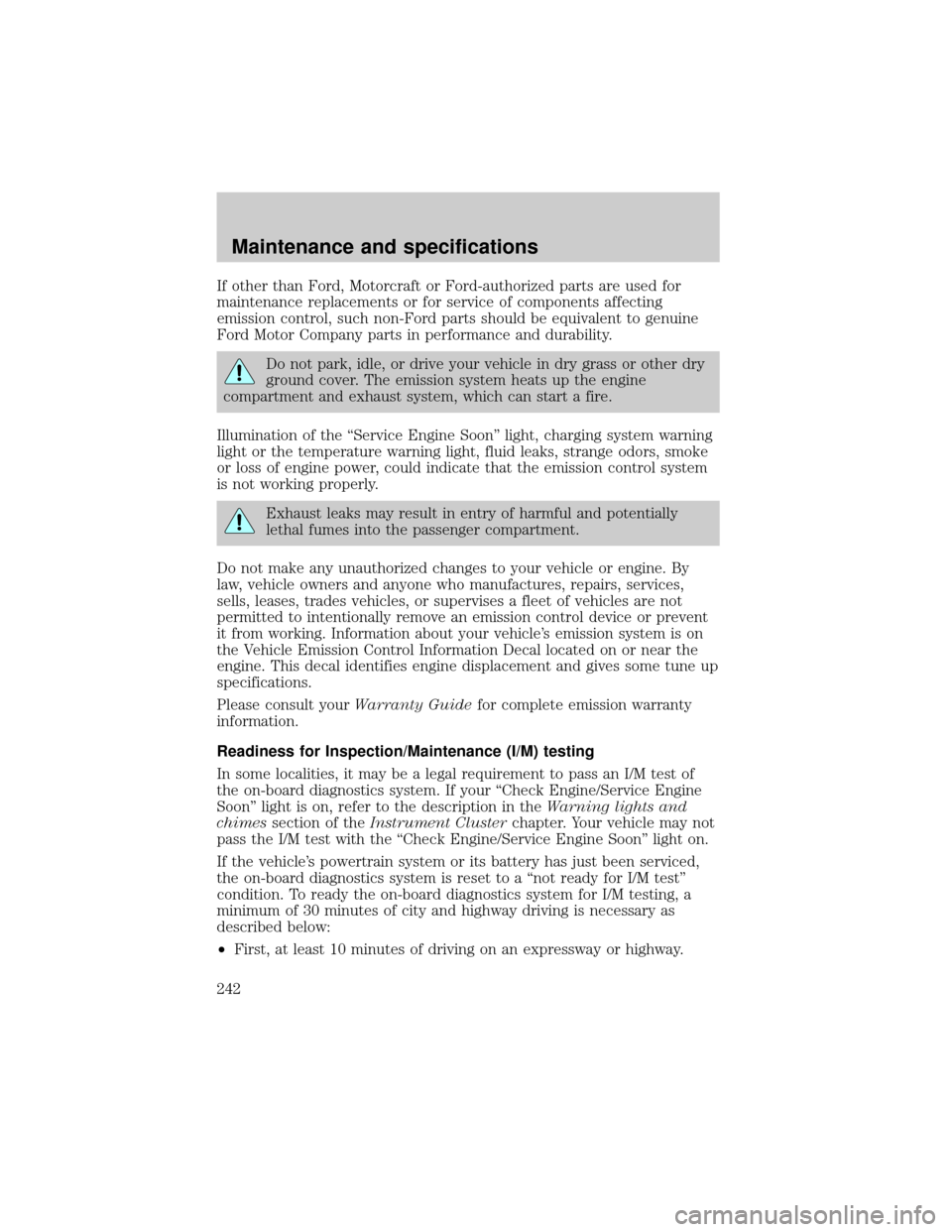
If other than Ford, Motorcraft or Ford-authorized parts are used for
maintenance replacements or for service of components affecting
emission control, such non-Ford parts should be equivalent to genuine
Ford Motor Company parts in performance and durability.
Do not park, idle, or drive your vehicle in dry grass or other dry
ground cover. The emission system heats up the engine
compartment and exhaust system, which can start a fire.
Illumination of the ªService Engine Soonº light, charging system warning
light or the temperature warning light, fluid leaks, strange odors, smoke
or loss of engine power, could indicate that the emission control system
is not working properly.
Exhaust leaks may result in entry of harmful and potentially
lethal fumes into the passenger compartment.
Do not make any unauthorized changes to your vehicle or engine. By
law, vehicle owners and anyone who manufactures, repairs, services,
sells, leases, trades vehicles, or supervises a fleet of vehicles are not
permitted to intentionally remove an emission control device or prevent
it from working. Information about your vehicle's emission system is on
the Vehicle Emission Control Information Decal located on or near the
engine. This decal identifies engine displacement and gives some tune up
specifications.
Please consult yourWarranty Guidefor complete emission warranty
information.
Readiness for Inspection/Maintenance (I/M) testing
In some localities, it may be a legal requirement to pass an I/M test of
the on-board diagnostics system. If your ªCheck Engine/Service Engine
Soonº light is on, refer to the description in theWarning lights and
chimessection of theInstrument Clusterchapter. Your vehicle may not
pass the I/M test with the ªCheck Engine/Service Engine Soonº light on.
If the vehicle's powertrain system or its battery has just been serviced,
the on-board diagnostics system is reset to a ªnot ready for I/M testº
condition. To ready the on-board diagnostics system for I/M testing, a
minimum of 30 minutes of city and highway driving is necessary as
described below:
²First, at least 10 minutes of driving on an expressway or highway.
Maintenance and specifications
242
Page 267 of 272

A
Air bag supplemental restraint
system ........................................132
and child safety seats ............134
description ..............................132
disposal ....................................137
driver air bag ..........................135
indicator light ...................14, 136
operation .................................135
passenger air bag ...................135
Air cleaner filter ...............247, 253
Air conditioning
manual heating and air
conditioning system .................79
Ambulance packages ....................7
Antifreeze (see Engine
coolant) .....................................226
Anti-lock brake system (see
Brakes) ..............................152±153
Audio system (see Radio) ...20, 41
Automatic transmission
driving an automatic
overdrive .................................157
fluid, adding ............................245
fluid, checking ........................245
fluid, refill capacities ..............254
fluid, specification ..................260
Auxiliary power point .................96
Axle
lubricant specifications ..258, 260
refill capacities ........................254
traction lok ..............................155
B
Battery .......................................220
acid, treating emergencies .....220charging system warning light 14
disconnecting ..........................222
jumping a disabled battery ....191
maintenance-free ....................220
replacement, specifications ...253
servicing ..................................220
voltage gauge ............................18
Belt minder ...............................127
Brakes ........................................152
anti-lock ...........................152±153
anti-lock brake system (ABS)
warning light .....................13, 153
brake warning light ..................13
fluid, checking and adding ....244
fluid, refill capacities ..............254
fluid, specifications .........258, 260
lubricant specifications ..258, 260
shift interlock ..........................156
Break-in period .............................5
C
Capacities for refilling fluids ....254
Child safety restraints ..............138
child safety belts ....................138
Child safety seats ......................139
in front seat ............................140
in rear seat ..............................140
tether anchorage hardware ...143
Cleaning your vehicle
engine compartment ..............209
exterior ....................................212
instrument cluster lens ..........211
instrument panel ....................211
interior .....................................211
plastic parts ............................210
safety belts ..............................212
washing ....................................207
waxing .....................................207
Index
267
Page 268 of 272

wheels ......................................208
windows ..................................212
wiper blades ............................210
Clock ..........................23, 28, 37, 45
Compass, electronic ..................104
calibration ...............................106
set zone adjustment ...............105
Console
overhead ..........................102±103
Controls
power seat ...............................114
Coolant
checking and adding ..............226
refill capacities ................230, 254
specifications ..................258, 260
Cruise control (see Speed
control) ........................................98
Customer Assistance ................173
Ford accessories for your
vehicle .....................................212
Ford Extended Service Plan .199
Getting assistance outside the
U.S. and Canada .....................203
Getting roadside assistance ...173
Getting the service you
need .........................................197
Ordering additional owner's
literature .................................204
The Dispute Settlement
Board .......................................200
Utilizing the
Mediation/Arbitration
Program ...................................203
D
Daytime running lamps (see
Lamps) .........................................85Dipstick
automatic transmission fluid .245
engine oil .................................217
Doors
door ajar warning .....................15
lubricant specifications ..........258
Driveline universal joint and
slip yoke ....................................245
Driving under special
conditions
through water .........................160
E
Emergencies, roadside
jump-starting ..........................191
Emission control system ..........241
Engine ................................260±261
check engine/service engine
soon light ..................................12
cleaning ...................................209
coolant .....................................226
diesel ...........................................6
fail-safe coolant ......................231
idle speed control ...................220
lubrication specifications ......258,
260
refill capacities ........................254
service points ..........................216
starting after a collision .........175
Engine block heater .................151
Engine oil ..................................217
checking and adding ..............217
dipstick ....................................217
filter, specifications ........219, 253
recommendations ...................219
refill capacities ........................254
specifications ..................258, 260
Index
268
Page 269 of 272

Exhaust fumes ..........................151
F
Fail safe cooling ........................231
Fluid capacities .........................254
Four-Wheel Drive vehicles
preparing to drive your
vehicle .....................................156
Fuel ............................................233
calculating fuel economy .......238
cap ...........................................235
capacity ...................................254
choosing the right fuel ...........236
comparisons with EPA fuel
economy estimates .................241
detergent in fuel .....................237
filling your vehicle with
fuel ...........................233, 235, 238
filter, specifications ........238, 253
fuel pump shut-off switch .....175
gauge .........................................18
improving fuel economy ........238
low fuel warning light ..............14
octane rating ...........236, 260±261
quality ......................................237
running out of fuel .................237
safety information relating to
automotive fuels .....................233
Fuses ..................................177±178
G
Garage door opener ..................103
Gas cap (see Fuel cap) ............235
Gas mileage (see Fuel
economy) ...................................238
Gauges .........................................16
battery voltage gauge ...............18engine coolant temperature
gauge .........................................17
engine oil pressure gauge ........17
fuel gauge ..................................18
odometer ...................................19
speedometer .............................18
trip odometer ............................19
GAWR (Gross Axle Weight
Rating) .......................................160
calculating ...............................163
definition .................................160
driving with a heavy load ......160
location ....................................160
GVWR (Gross Vehicle Weight
Rating) .......................................160
calculating .......................160, 163
definition .................................160
driving with a heavy load ......160
location ....................................160
H
Hazard flashers .........................174
Headlamps ...................................85
aiming ........................................86
bulb specifications ....................88
daytime running lights .............85
flash to pass ..............................86
high beam ...........................15, 85
replacing bulbs ...................89±90
turning on and off ....................85
warning chime ..........................16
Heating
auxiliary heater and air
conditioner ................................83
heater only system ...................78
heating and air conditioning
system .......................................79
Hood ..........................................215
Index
269
Page 270 of 272

I
Ignition .......................148, 260±261
Infant seats
(see Safety seats) .....................139
Inspection/maintenance (I/M)
testing ........................................242
Instrument panel
cleaning ...................................211
cluster ................................12, 211
lighting up panel and
interior .......................................86
J
Jack ............................................184
positioning ...............................184
storage .....................................184
Jump-starting your vehicle ......191
K
Keys
key in ignition chime ...............16
positions of the ignition .........148
L
Lamps
bulb replacement
specifications chart ..................88
cargo lamps ...............................86
daytime running light ...............85
headlamps .................................85
headlamps, flash to pass ..........86
instrument panel, dimming .....86
interior lamps ...........................87
replacing bulbs ...................88±93
Lane change indicator (see
Turn signal) .................................86Lights, warning and indicator ....12
air bag ........................................14
anti-lock brakes (ABS) ....13, 153
brake ..........................................13
charging system ........................14
check coolant ............................14
cruise indicator .........................14
door ajar ....................................15
engine oil pressure ...................14
high beam .................................15
low fuel ......................................14
safety belt .................................13
service engine soon ..................12
turn signal indicator .................15
Load limits .................................160
GAWR ......................................160
GVWR ......................................160
trailer towing ..........................160
Loading instructions .................162
Lubricant specifications ...258, 260
Lumbar support, seats .............114
M
Mirrors
fold away ...................................98
side view mirrors (power) .......97
Motorcraft parts ................238, 253
O
Octane rating ............................236
Odometer .....................................19
Oil (see Engine oil) ..................217
Overdrive ...................................102
Index
270